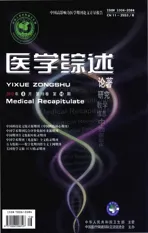间充质干细胞治疗1型糖尿病的免疫调节机制研究进展
2012-12-09张双双综述审校
吴 舟,张双双(综述),陈 宏(审校)
(1.南方医科大学第二临床医学院,广州510282;2.南方医科大学附属珠江医院内分泌与代谢病科,广州510282)
1型糖尿病(type 1 diabetes mellitus,T1DM)是一种由T细胞介导的自身免疫性疾病,以胰岛β细胞被破坏为特征,从而引起血糖升高,既往曾称为胰岛素依赖型糖尿病[1]。治疗T1DM的理想方法应能保护残存的胰岛β细胞数量和功能,保护移植的胰岛细胞不受自身免疫攻击[2]。间充质干细胞(mesenchymal stem cells,MSCs)是一类具有特殊免疫调节作用的干细胞,它可以产生一系列细胞因子,作用于抗原呈递细胞、T细胞和自然杀伤细胞等免疫细胞而抑制机体免疫功能的发挥[3]。目前已证明,MSCs在同种异基因胰岛移植中可抑制异体免疫反应,减轻移植相关的排斥反应,并明显延长胰岛的存活期[4]。MSCs成为广为关注的有可能在抗移植排斥和自身免疫性疾病治疗中最有应用潜能的工具细胞[5-6]。有大量旨在阐明MSCs治疗T1DM中作用机制的实验研究先后开展,相应地提出了多个假说。现就近来报道的关于MSCs治疗T1DM免疫调节机制的相关文献进行简要综述。
1 MSC抑制T细胞免疫反应途径,阻止T1DM自身免疫发展
T淋巴细胞对胰岛的浸润和破坏是T1DM发病的中心环节,MSC可以通过抑制T细胞的活化和增殖来抑制T细胞参与的β细胞破坏的自身免疫过程。Madec等[7]研究发现可能是因为MSCs能更早地迁移到胰淋巴结内,阻止致病性的T细胞进入胰岛,从而阻止糖尿病的发生。MSCs的迁移能够阻止致病性的T细胞减少调节性T细胞(regulatory T cells,Tregs)的数量,抑制胰岛素增殖和自体移植物引起的反应。并且MSCs能诱导分泌白细胞介素 (interleukin,IL)-10的FOXP3+T细胞的产生。Urbán等[8]在糖尿病鼠的研究结果强烈提示,MSCs能抑制T细胞对新形成的β细胞介导的免疫反应,使其周围免疫环境改变时β细胞得以存活,从而阻止T1DM的发展。MSC抑制T细胞的活化与增殖可能通过多种方式来实现,如通过释放细胞因子来间接或直接调控T细胞相关性受体或配体,以及经与靶细胞相互间接触来抑制T细胞活化与增殖。
目前体外实验已证实MSC通过分泌免疫抑制因子,如肝细胞因子、转化生长因子β1、吲哚胺2,3-过氧化酶(indoleamine 2,3,dioxygenase,IDO)、一氧化氮[9]、地诺前列酮[10]、IL-10发挥抑制T淋巴细胞增殖的作用。MSC可通过活化的T细胞分泌的干扰素γ (interferon,IFN-γ)正性调节MSC分泌的IDO,从而达到抑制T细胞增殖的目的。MSC还能通过分泌基质金属蛋白酶来抑制T细胞增殖[11]。基质金属蛋白酶能裂解T细胞胞外白细胞介素2受体α(IL-2 receptor α,IL-2Rα),使IL-2的生成减少,从而抑制T细胞活化[12]。
2 MSC诱导辅助性T细胞的分化偏移发挥免疫调节作用
目前认为Th1/Th2细胞功能失衡是T1DM发病机制的重要因素,Th1细胞及其分泌的IFN-γ、IL-2、肿瘤坏死因子(tumor necrosis factor,TNF)β等细胞因子对胰岛β细胞具有损伤作用,Th2细胞及其分泌的IL-4、IL-5、IL-6、IL-10等细胞因子具有保护作用。这两种细胞通过所分泌的细胞因子相互制约,处于动态平衡状态。对于T1DM患者来说,若体内Th1/ Th2细胞群功能失衡,前者强于后者,会导致胰岛β细胞的损伤,胰岛素的缺乏。
近来证实MSCs可以分泌细胞因子诱导Th1/ Th2细胞群的失平衡,使其向具有抗炎性反应的Th2细胞群转化[13]。它可以抑制Th1细胞产生的细胞因子的表达和上调Th2产生的细胞因子的表达。静脉滴注MSCs引起Th1分泌细胞因子减少,特别是IFN-γ和TNF-α;MSCs通过促进IL-10的分泌,抑制Th1和自然杀伤细胞释放 IFN-γ,促进 Th2分泌 IL-4[10]。Fiorina等[14]将BALB/c-MSC小鼠和NOD小鼠作为对照,发现前者能表达更高水平的负性PD-L1分子,以此可以促进向Th2细胞群的转化,而且来自NOD小鼠的MSCs可以阻止处在糖尿病前期的小鼠发展为糖尿病。
3 MSC通过调控Tregs发挥免疫调控作用
Tregs是T细胞的一种特殊亚群,能表达转录因子FOXP3[15]和抑制自身反应性T细胞[16],降低免疫反应,从而调控自身免疫性疾病,对维持内环境稳定和自我免疫耐受有着重要作用。在T1DM患者和NOD小鼠模型的研究都表明,数量降低和功能异常的Tregs都与T1DM的发病原因密切相关[17-18]。
Di等[18]发现 MSC通过下调能抑制 FOXP3的CD127分子,以促进FOXP3表达,进而募集Tregs、调节并维持Tregs的表型和功能,从而达到免疫抑制功能。自体来源的大鼠骨髓MSC移植不仅可以促进胰岛中胰岛素的分泌,还能促进外周T细胞分泌IL-10,增加外周血中的的数量,从而维持血糖稳定较长时间[19]。Prevosto等[20]认为Tregs可以放大MSC的免疫抑制作用。Patel等[21]证实在BMSCs与外周血单核细胞共培养体系中,BMSCs分泌的转化生长因子β1能增加Tregs的数量。MSC能通过分泌IDO来促进Tregs生成,因为IDO能促进Tregs的产生[22]。
4 MSC通过与多种免疫活性细胞相互作用发挥免疫调节作用
B淋巴细胞、DC等免疫活性细胞在T1DM的发病机制中同样发挥重要作用。B细胞侵入胰岛并发挥抗原呈递细胞的作用,聚集其他免疫活性细胞至胰岛并分泌肿瘤坏死因子及其他炎性因子还有自身抗体,从而直接导致胰岛细胞的破坏。DC抑制T1DM的发生需要表达糖尿病特异性抗原[23-24]。DC能分泌TNF-α等细胞因子促进胰岛炎性反应,同时也发挥抗原呈递的作用。胰岛细胞TNF-α表达的上调可以导致NOD小鼠T1DM的发生和发展[25]。
MSC分泌多种因子与B细胞、DC细胞等免疫活性细胞相互作用,形成一种相互交错的复杂关系,发挥其免疫调节作用。Abdi等[26]认为MSCs不仅可以调控DC的功能从而间接控制糖尿病的发生,还可以调节T细胞功能,纠正B淋巴细胞和自然杀伤细胞的功能异常。
Steptoe等[27]将表达自身抗原的未成熟DC转移给NOD鼠,其T1DM被阻止。MSC不仅可以抑制单核细胞分化为DC,还可以通过降低CD83表达和调节细胞因子来抑制DC的成熟,如TNF-α下调和IL-10上调等。Glennie等[28]发现MSCs能通过产生转化生长因子β下调或阻断IL-7来抑制B细胞的增殖分化。Corcione等[29]研究也发现MSCs有抑制B细胞的作用,主要通过使B淋巴细胞停留在G0/G1期来抑制其增殖。此外,当MSCs与B淋巴细胞共培养时,B淋巴细胞产生的IgM、IgG和IgA明显下降。
5 小结
各种淋巴细胞及DC细胞对T1DM胰岛炎的发生和胰岛β细胞损伤起着不同的作用,而MSC能抑制T细胞和B细胞增殖活化、平衡Th1/Th2细胞群、诱导Tregs产生、抑制树突状细胞成熟,在诱导免疫耐受等方面可能对T1DM可以起到有效积极的预防和治疗作用。
然而,尽管 MSCs显示出抗移植排斥和治疗T1DM的巨大潜能,但目前MSCs在诱导机体免疫耐受的理论仍不成熟,很多结论尚停留在推论的范畴,对MSCs的研究仍处于实验研究阶段,需要大规模的样本验证,离临床应用还有很长一段距离。此外,因为实验条件及MSCs的来源不同,MSCs对各种免疫细胞的抑制作用可能得出不同的结论,细胞治疗国际协会对人类MSCs的来源提出了基本标准,日后相关的研究应当遵循指导方针[30]。但是MSCs针对T1DM发病原因提供了治疗方案,如果能明确MSCs的免疫抑制机制,并与临床研究相结合运用,相信MSCs可以为T1DM治疗带来新的希望。
[1] Haller MJ,Viener HL,Wasserfall C,et al.Autologous umbilical cord blood infusion for type 1 diabetes[J].Exp Hematol,2008,36 (6):710-715.
[2] Fiorina P,Voltarelli J,Zavazava N.Immunological applications of stem cells in type 1 diabetes[J].Endocr Rev,2011,32(6): 725-54.
[3] Uccelli A,Pistoia V,Moretta L.Mesenchymal stem cells:a new strategy for immunosuppression?[J].Trends Immunol,2007,28 (5):219-226.
[4] Figliuzzi M,Cornolti R,Perico N,et al.Bone marrow-derived mesen-chymal stem cells improve islet graft function in diabetic rats[J].Transplant Proc,2009,41(5):1797-1800.
[5] Le Blanc K,Ringden O.Immunobiology of human mesenchymal stem cells and future use in hematopoietic stem cell transplantation[J].Biol Blood Marrow Transplant,2005,11(5):321-334.
[6] Uccelli A,Moretta L,Pistoia V.Immunoregulatory function of mesenchymal stem cells[J].Eur J Immunol,2006,36(10):2566-2573.
[7] Madec AM,Mallone R,Afonso G,et al.Mesenchymal stem cells protect NOD mice from diabetes by inducing regulatory T cells[J].Diabetologia,2009,52(7):1931-1939.
[8] Urbán VS,Kiss J,Kovács J,et al.Mesenchymal stem cells cooperate with bone marrow cells in therapy of diabetes[J].Stem Cells,2008,26(1):244-253.
[9] Sato K,Ozaki K,Oh I,et al.Nitric oxide plays a critical role in suppression of T cell proliferation by mesenchymal stem cells[J].Blood,2007,109(1):228-234.
[10] Aggarwal S,Pittenger MF.Human mesenchymal stem cells modulate allogeneic immune cell responses[J].Blood,2005,105(4): 1815-1822.
[11] Ding Y,Xu D,Feng G,et al.Mesenchymal stem cells prevent the rejection of fully allogenic islet grafts by the immunosuppressive activity of matrix metalloproteinase-2 and-9[J].Diabetes,2009,58 (8):1797-1806.
[12] Park MJ,Shin JS,Kim YH,et al.Murine mesenchymal stem cells suppress T lymphocyte activation through IL-2 receptor α(CD25) cleavage by producing matrix metalloproteinases[J].Stem Cell Rev,2011,7(2):381-393.
[13] McClymont SA,Putnam AL,Lee MR,et al.Plasticity of human regulatory T cells in healthy subjects and patients with type 1 diabetes[J].J Immunol,2011,86(7):3918-3926.
[14] Fiorina P,Jurewicz M,Augello A,et al.Immunomodulatory function of bone marrow-derived mesenchymal stem cells in experimental autoimmune type 1 diabetes[J].J Immunol,2009,15,183(2): 993-1004.
[15] Zhao Y,Lin B,Darflinger R,et al.Human cord blood stem cellmodulated regulatory T lymphocytes reverse the autoimmunecaused type 1 diabetes in nonobese diabetic(NOD)mice[J].PLoS One,2009,4(1):e4226.
[16] Brusko T,Wasserfall C,McGrail K,et al.No alterations in the frequency of FOXP3+regulatory T-cells in type 1 diabetes[J].Diabetes,2007,56(3):604-612.
[17] Brusko TM,Wasserfall CH,Clare-Salzler MJ,et al.Functional defects and the influence of age on the frequency of CD4+CD25+T-cells in type 1 diabetes[J].Diabetes,2005,54(5):1407-1414.
[18] Di Ianni M,Del Papa B,De Ioanni M,et al.Mesenchymal cells recruit and regulate T regulatory cells[J].Exp Hematol,2008,36 (3):309-318.
[19] Boumaza I,Srinivasan S,Witt WT,et al.Autologous bone marrowderived rat mesenchymal stem cells promote PDX-1 and insulin expression in the islets,alter T cell cytokine pattern and preserve regulatory T cells in the periphery and induce sustained normoglycemia[J].J Autoimmun,2009,32(1):33-42.
[20] Prevosto C,Zancolli M,Canevali P,et al.Generation of CD4+or CD8+regulatory T cells upon mesenchymal stem cell-lymphocyte interaction[J].Haematologica,2007,92(7):881-888.
[21] Patel SA,Meyer JR,Greco SJ,et al.Mesenchymal stem cells protect breast cancer cells through regulatory T cells:role of mesenchymal stem cell-derived TGF-beta[J].J Immunol,2010,184 (10):5885-5894.
[22] Ge W,Jiang J,Arp J,et al.Regulatory T-cell generation and kidney allograft tolerance induced by mesenchymal stem cells associated with indoleamine 2,3-dioxygenase expression[J].Transplantation,2010,90(12):1312-1320.
[23] Han B,Serra P,Yamanouchi J,et al.Developm ental control of CD8T cell-avidity maturation in autoimmune diabetes[J].J Clin Invest,2005,115(7):1879-1887.
[24] Prasad SJ,Goodnow CC.Intrinsic in vitro abnormalities in dendritic cell generation caused by non-MHC non-obese diabetic genes[J].Immunol Cell Biol,2002,80(2):198-206.
[25] Novak J,Griseri T,Beaudoin L,et al.Regulation of type 1 diabetes by NKT cells[J].Int Rev Immunol,2007,26(1/2):49-72.
[26] Abdi R,Fiorina P,Adra CN,et al.Immunomodu lation by mesenchymal stem cells:a potential therapeutic strategy for type 1 diabetes[J].Diabetes,2008,57(7):1759-1767.
[27] Steptoe RJ,Ritchie JM,Jones LK,et al.Autoimmune diabetes is suppressed by transfer of proinsulin-encoding Gr-1+myeloid progenitor cells that differentiate in vivo into resting dendritic cells[J].Diabetes,2005,54(2):434-442.
[28] Glennie S,Soeiro I,Dyson PJ,et al.Bone marrow mesenchymal stem cells induce division arrest anergy of activated T cells[J].Blood,2005,105(7):2821-2827.
[29] Corcione A,Benvenuto F,Ferretti E,et al.Human mesenchymal stem cells modulate B-cell functions[J].Blood,2006,107(1): 367-372.
[30] Dominici M,Le Blanc K,Mueller I,et al.Minimal criteria for defining multipotent mesenchymal stromal cells:the International Society for Cellular Therapy position statement[J].Cytotherapy,2006,8(4):315-317.
